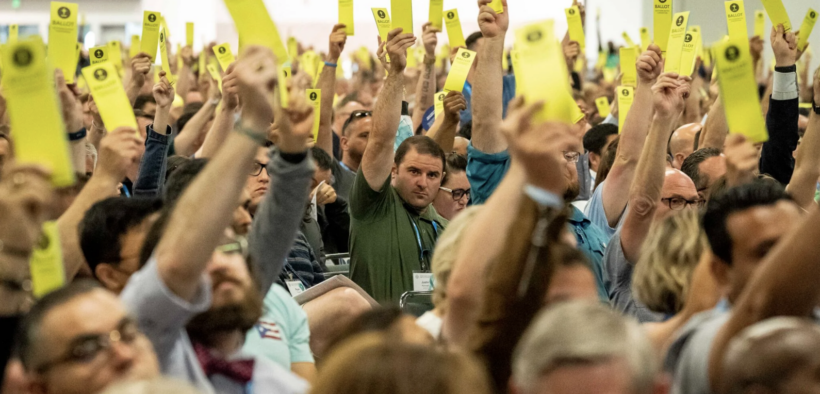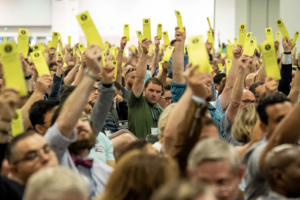SBC to Take up Issue of Women Pastors at 2023 Annual Conference
More than 12,000 local church representatives, known as messengers, will gather in New Orleans, ready to do their denomination's business.

(RNS) — Membership in the Southern Baptist Convention’s constituent churches has been plummeting, its national leaders are feuding or quitting, and any good work the denomination could boast about has been largely overshadowed by a sex abuse crisis.

Messengers vote during the SBC annual meeting in Anaheim, California, in June 2022 / RNS photo by Justin L. Stewart
Just this week, one of the SBC’s major seminaries announced that its leaders had run up $140 million in deficits over the past two decades, depleting the school’s reserve and leaving it in an ongoing financial crisis.
Alongside these existential challenges, Southern Baptists, like other Americans, have indulged in the nation’s ongoing “woke wars,” in which discussion of policy governing race, education and other issues quickly devolves into a shouting match, especially on social media.
All these factors threaten to erode the SBC’s so-called “rope of sand” — bonds of trust, rather than official hierarchy or legal ownership, that bind together the 40,000 churches and 13 million members of the nation’s largest Protestant denomination.
Yet most of the denomination’s adversity will be overshadowed during the SBC’s annual meeting in New Orleans this week by a slow-simmering debate that has heated up among Baptists over the past few years: What should be done about the handful of women who serve as pastors at SBC churches?
During the opening day of the SBC’s annual meeting, which runs June 13-14, thousands of local church delegates, known as messengers, will consider appeals from a pair of congregations that have been expelled for employing women as pastors, which conflicts with the denomination’s statement of faith. The messengers are also expected to debate a proposed constitutional amendment that would make it clear that churches with women pastors cannot be part of the SBC.
Access to MinistryWatch content is free. However, we hope you will support our work with your prayers and financial gifts. To make a donation, click here.
The SBC Executive Committee voted Monday (June 12) to approve placing the amendment before the messengers, or delegates, during this year’s meeting. But they also noted their opposition to changing the constitution to address the debate, with some members saying during the meeting that the faith statement is the place for such doctrinal issues.
“While the messengers to the 2022 SBC Annual Meeting entrusted the Executive Committee with this motion, we recognize the significance of the matter, at this given time, and therefore believe it is prudent to place the referred motion before the entire body of messengers,” the committee stated, “while also expressing our opposition to the suggested amendment to SBC Constitution Article III.”
FernAt stake at the meeting is not only the role of women in the church, but a broader question about how closely a church needs to identify overall with the Baptist Faith & Message to remain “in friendly cooperation” with the convention.
Southern Baptists have long argued over the role of women in the church. In 1885, a group of Virginia women showed up at the annual meeting as messengers. Baptist leaders admitted that no rule barred their presence but barred them anyway, then changed the rules so that only “brethren” were allowed. The rules were later changed back.
In 2000, the statement of faith was updated to hold that men and women are “gifted for service in the church” but restricts the office of pastor to men alone. Some believe that means women cannot do any of the things that male pastors do — lead a church, preach during worship services or oversee both men and women. Others say that only the office of senior pastor of a church is limited to men.
Yet for decades, women served as missionaries, teaching and sometimes preaching. In the 1960s, women began to serve as SBC pastors, with their number growing to at least several hundred by the 1980s. That changed after the so-called Conservative Resurgence took over the convention and drove off more moderate Baptists who supported women pastors. Other women pastors left on their own.
At Fern Creek Baptist Church in Louisville, Kentucky, the Rev. Linda Popham has served for 40 years, the last 30 as senior pastor. The church holds to a 1963 version of the Baptist Faith & Mission, which makes no mention of gender when it comes to pastors.
Fern Creek was among five churches removed from the SBC in February for having female pastors — the first time that the denomination has acted on a national level to do so. Fern Creek will appeal that decision this week, as will another disfellowshipped church, Saddleback Church in California, founded by bestselling author Rick Warren. After Warren’s retirement last year, Stacie Wood was named teaching pastor beside her husband, senior pastor Andy Wood.
Popham, who spent last week at her church’s Vacation Bible School, said the move to kick her church out of the SBC is baffling. The church works closely with its local Baptist association and state convention, gives to SBC missions, does door-to-door evangelism and runs a host of SBC-related programs. A lifelong Baptist, she has served on state committees, hosted SBC leaders at her church and gone on a dozen international mission trips.
“We have been in friendly cooperation with the SBC all these years,” she said. “It makes no sense. What happened in the last two years?”
The answer might have to do, at least in part, with Donald Trump and the SBC’s abuse crisis. The current debate over women pastors and preachers actually goes back to 2019, when the popular Southern Baptist Bible teacher Beth Moore referred on Twitter to a recent appearance she’d made at a church on Mother’s Day. Moore had already earned the ire of some Baptist leaders for being critical of Trump’s treatment of women. Her Mother’s Day tweet gave her opponents a doctrinal weapon.
At the time, the SBC was dealing with the fallout of a Houston Chronicle report that found hundreds of cases of sexual abuse in recent decades by SBC pastors and church leaders. Then the conversation changed.
“We were in the middle of the biggest sexual abuse scandal that has ever hit our denomination,” she told Religion News Service in 2021. “And suddenly, the most important thing to talk about was whether or not a woman could stand at the pulpit and give a message.”
Moore would eventually leave the SBC altogether.
The debate over women pastors blew up again in 2021 after Saddleback Church announced it had ordained three women on staff as pastors. That led to calls to kick Saddleback, and churches like it, out.
Mike Law, the Virginia pastor who proposed the amendment to bar churches with women pastors, has compiled a list of 170 women. Fewer than a third are senior pastors. The rest are associate pastors, children’s pastors or fill other staff roles. The amendment, if passed, would only allow churches to cooperate with the SBC if they do not “affirm, appoint, or employ a woman as a pastor of any kind.”
The continued focus on women in the church has been exhausting, said Bible teacher and author Jacki King.
“A big chunk of Southern Baptists are just really discouraged,” said King, who is the minister to women at Second Baptist Church in Conway, Arkansas, where her husband is pastor.
King said she believes only men should be pastors, but the recent conflicts, she said, have cast suspicion on any woman who holds a significant role or even speaks at events when both men and women are present. King found herself under fire a few years ago for speaking during a chapel service at a Christian college, which was seen by critics as a violation of Scripture.
Despite the tensions, women still want to serve in the church, said King. She pointed to the consistent presence of women at SBC seminaries and other schools of theology.
Women make up almost 1 in 4 (24%) students at Southern seminary, the SBC’s flagship seminary, and at Southwestern Baptist Theological Seminary in Texas (24%). A third of the students at Southeastern Baptist Theological Seminary in North Carolina this spring were women, and nearly that many (29%) were at New Orleans Baptist Theological Seminary, according to data supplied by the seminaries.
Few faculty are women, ranging from 4% at Southern to 12% at New Orleans seminary. Those female faculty tend to hold positions related to counseling, education, women’s ministry or libraries.
Nationwide, women make up about 10% of clergy in the United States, according to the 2020 Faith Communities Today study. About a third (32%) of mainline Protestant churches had women pastors. Only 4% of evangelical congregations have a woman pastor.
Katie J. McCoy, an author and former seminary professor and now director of women’s ministry for Texas Baptists, said that women still want to learn theology in order to understand the Bible better. In her role, she helps run education programs for women leaders at churches, putting her experience as a seminary professor to work on a statewide basis.
She said she’s hopeful that many younger pastors care about doctrine but also want to empower women in the church.
This is an ongoing story and will be updated.
Adelle M. Banks contributed to this report



